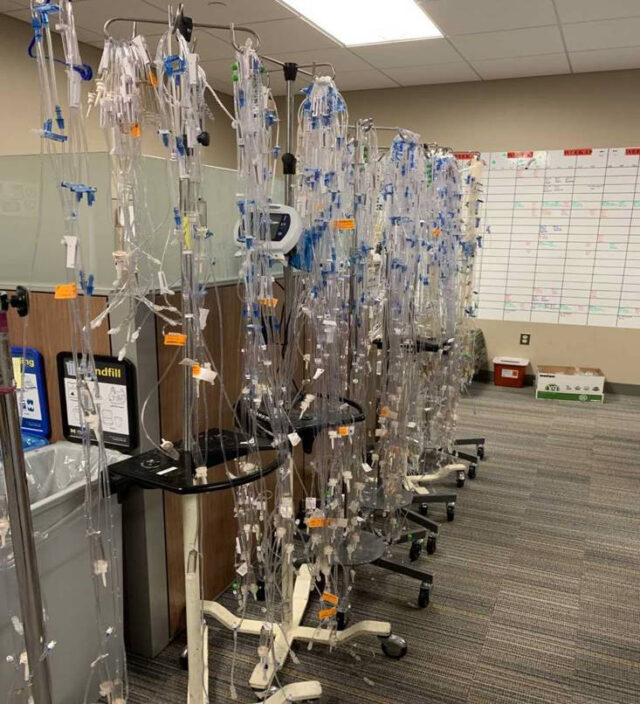
Intravenous tubing collected by the Clinical Nursing Center during its waste reduction and materials reuse efforts. (Photo courtesy of School of Nursing’s Clinical Learning Center)
As various units work to advance the University of Michigan’s commitment to carbon neutrality, the School of Nursing’s Clinical Learning Center is leading a new approach to waste reduction that it hopes may expand within and beyond the nursing field.
Proponents see the effort as environmentally sustainable, financially responsible, and scalable for adaptation elsewhere.
At the center, students hone their skills in a simulated environment, designed to replicate real health care scenarios. And because it is a simulated space, as opposed to one for critical care, practitioners are successfully reusing materials to reduce waste, and hoping to elevate their approach as a best practice.
“In one semester, we collected over 300 pounds of plastic IV (intravenous) tubing — a pretty astounding amount of plastic waste,” said Melissa Bathish, the center’s co-director and undergraduate faculty lead.
“So we created a task force, with students and faculty, to examine potential sustainability efforts. We also polled students for their input on what we can reuse and how much we can reuse it, and we came up with some guidelines.”
Efforts soon snowballed into a national survey that drew 71 responses. From this, Bathish learned that most institutions were reusing materials for nursing simulations, but that no clear and universally adopted set of guidelines yet existed.
“Very few respondents had formal plans, but most did reuse and try to recycle,” she said.
Out of a desire to elevate best practices, Bathish and colleagues Deb Lee, Jessica Marsack and Meg Czerwinski joined representatives from 12 other institutions to launch a special interest group on sustainability within the International Nursing Association of Clinical and Simulation Learning, which oversees standards for the field.
While the group’s work is underway and the Clinical Learning Center awaits the responses of a similar international survey, the center is looking to scale its approach beyond nursing, to fields like medicine and dentistry, which also incorporate simulated environments that rely on traditionally single-use plastics.
The center also is examining the feasibility of 3D-printing syringes, IV tubing and other supplies, recognizing that the quality of simulation materials does not have to match that required for real-life medical situations.
In addition, the center and other like-minded university units are reaching out to large medical suppliers to explore ways to recycle simulation materials that would otherwise be thrown away. IV tubing, for example, is made with multiple types of plastics that, together, are difficult to recycle in routine ways and often are not accepted by recycling companies.
Some situations still require the use of new medical supplies each time, such as examinations, where students must check off various steps they would take in a clinical environment. For students who are practicing, however, the center cleans, dries and reseals kits — a time-consuming process, but one that pays off for cost-savings and the environment.
Ultimately, Bathish wants to codify the approach.
“There’s nothing about sustainability in nursing simulation best practices. INACSL guidelines are used around the world, so if we can make an impact there, it could be really widespread,” she said.
The center also supported Innovate 4 Change, a student-led hackathon within the School of Nursing that aims to spur interdisciplinary advances in the field as it relates to environmental sustainability, health equity, safety and global health.
One participating group examined the feasibility of recycling nitrile gloves, which the Clinical Learning Center and the broader health care field use in abundance.
These efforts within the school support a broader U-M sustainability goal to reduce the amount of waste sent to landfills from the Ann Arbor campus by 40 percent (from a 2006 baseline) by 2025. The goal was established in 2011.
More recently, U-M committed to achieving carbon neutrality universitywide, across all greenhouse gas emission categories. As part of this effort, one priority is to collaborate with academic leaders from all schools, colleges and units to better integrate sustainability into campus culture and core curricula.
In addition, centrally coordinated efforts toward geothermal heating and cooling projects, fleet electrification, renewable power purchasing and other key priorities are underway.


